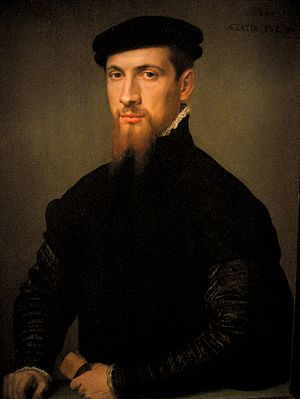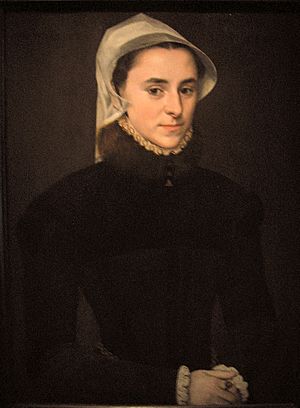Simon Renard facts for kids
Quick facts for kids
Simon Renard de Bermont
|
|
|---|---|

Portrait of Simon Renard de Bermont by Anthonis Mor
|
|
| Born | 1513 |
| Died | 1573 |
| Occupation | Ambassador of Emperor Charles V, advisor of Philip II of Spain. |
| Spouse(s) | Jeanne Lullier |
Simon Renard (1513 – August 8, 1573) was a skilled diplomat from Burgundy. He was an important advisor to Emperor Charles V and his son Philip II of Spain. Both Charles V and Philip II were also rulers of Burgundy. Renard held a special role as a "Master of Requests" in the Emperor's court, meaning he handled important requests and legal matters.
He served as an ambassador for Spain in both France and England. When he was the ambassador to England, he gained a lot of power over Mary I of England. Many people believed he was controlling the English government, especially before Mary married Philip, a marriage Renard strongly supported.
Contents
Simon Renard's Life Story
Simon Renard was often known simply as Renard, which means "Fox" in English. He came from the town of Vesoul.
In May 1549, Renard was in Paris. He sent reports about talks between England and France that would end a war called the Rough Wooing. He also reported on France's plans to take and fortify Alderney island, and other ongoing wars. In July 1549, he wrote about how happy Henry II of France was when he received five English flags captured at Inchkeith.
Renard later joined other ambassadors in London as Edward VI of England was dying. He wrote to Antoine Perrenot de Granvelle, a powerful bishop, about how another ambassador, Jean Scheyfve, was jealous of Renard's leading role when they met with Mary I of England.
The Emperor called back the other ambassadors on September 14, 1553, leaving Renard in charge. When Renard heard this on September 20, he asked the Emperor if he could go back to Brussels to see his wife and children. He also reminded the Emperor that he had no secretary or money, as he thought he would only be in London for 40 days.
Mary I held a big dinner when Renard's fellow ambassadors left England in October 1553. Renard noticed that Princess Elizabeth, Mary's half-sister, and Lady Lennox, Mary's preferred heir, were sitting together. Renard then worked to arrange the marriage between Queen Mary I and the future King Philip II of Spain.
Renard's career as a diplomat eventually faced problems. His former secretary, Etienne Quiclet, sold Renard's secret codes and papers to the French. In September 1557, Quiclet was put on trial in France and revealed secrets that embarrassed Renard. Philip II, who had never fully trusted Renard, fired him the next year.
Princess Elizabeth's Troubles
In a report to Charles V about Thomas Wyatt's rebellion against Mary I, Renard described how Princess Elizabeth arrived at the Tower of London. Elizabeth came to London dressed in white, followed by a large crowd. Her carriage was open so people could see her. Her face was pale, but she looked proud to hide her upset feelings.
Mary I would not see Elizabeth, who was lodged in the Palace where she could be watched. Elizabeth was sent to the Tower by boat down the Thames River. Her arrival was delayed by a day, to March 18, 1554, because she missed the tide while writing a letter to Mary. Renard said that the Queen's council, not Mary herself, had arranged for Elizabeth to be moved.
Renard's Impact on England
Historians agree that Renard had a very strong influence over Queen Mary I. When he became the only ambassador in London, Mary wrote to Charles V that "his presence is and shall always be very acceptable to us." She trusted few of her English advisors. She once said she could "scarcely see any one of them who had not done her an injury."
However, she trusted the Emperor completely, so she was ready to listen to his envoy, Renard. His charm and intelligence did the rest. When he first arrived in England, he had actually told Mary to accept Lady Jane Grey as Queen. But Mary forgave this, as he was new to English politics. During Wyatt's Rebellion, he wisely told Mary to stay in London. He argued that losing control of the capital meant losing the crown itself.
On September 9, 1553, Renard described Mary to Bishop Granvelle as "good, easily influenced, inexpert in worldly affairs and a novice all round." He thought Princess Elizabeth should be feared because she had the "power of enchantment." Renard's biggest success was arranging Mary's marriage to Philip of Spain. He also advised her on many other topics, even religion, though he admitted he was not an expert on it.
However, Mary did not always follow his advice. She was much kinder to the supporters of Lady Jane Grey than he thought was wise. Despite his repeated urging, she never took strong action against her half-sister Elizabeth. Renard was not happy with the role of Parliament in England, but Mary decided to rule with Parliament's advice, like her father. For the difficult period known as the Marian Persecutions, Renard was not responsible. He was not a fanatic, and his letters show he was against the burning of people for their beliefs. He feared it might lead to a revolution.
After Mary's marriage, Renard's influence decreased because Philip suspected him. Renard asked to be recalled, but the Emperor refused. He believed Renard's experience in English affairs and Mary's liking for him made him too valuable. When Mary and Philip had problems in their marriage, Renard advised Philip that even if Mary was not as "agreeable and gracious" as he wished, she still deserved to be treated well.
When it became clear that Philip and Mary would not have children, Renard changed his mind. He urged Mary to make peace with Elizabeth and recognize her as the next in line to the throne. Even though Renard deeply distrusted Elizabeth, he was even less happy about the throne possibly going to Mary, Queen of Scots. Mary, Queen of Scots, was soon to marry Francis II of France, and was therefore linked to French interests.
Renard was finally called back from England in the autumn of 1555, as he had requested. However, he continued to advise the Emperor on English matters for some time afterward.
Renard's Reputation
Historians have praised Renard for his intelligence, patience, cleverness, and diplomatic skills. However, some English historians, like Mary's biographer H.F.M. Prescott, have judged him quite harshly. They argue that because he had so much influence over Mary in her early years as queen, he must share much of the blame for the problems that happened later in her reign.
His family's coat-of-arms was red with a gold chevron, which had three silver crescents on it.
See also
 In Spanish: Simon Renard para niños
In Spanish: Simon Renard para niños
- Antoine Perrenot de Granvelle
- County of Burgundy


